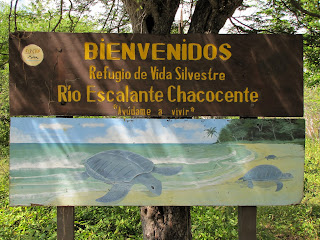The next stop on my "Tour of Nicaraguan Turtle Beaches" with FFI's Jose Urteaga is Refugio de Vida Silvestre Rio Escalante Chacocente, Chacocente for short. Chacocente is one of only two beaches on Nicaragua's Pacific coast where the Olive ridley sea turtle nests "in mass". This phenomenon, also known as an "arribada" which means "the arrival", only occurs on a small number of beaches in the Eastern Pacific and Indian Oceans - a handful occurring in Mexico, Nicaragua, Costa Rica, and Panama, and a few in India. Elsewhere in the world, the Olive Ridley is a solitary nester like other sea turtle species.
 |
| An Olive ridley track |
Much to my dismay an arribada occurred just a few days before my arrival here, with approximately 10,000 Olive ridley nests being deposited over the course of just a few days on this very beach that I am walking on. In my time working with sea turtles I have yet to witness an Olive ridley arribada but imagine it would leave me without words. Today, only a few scattered tracks remain on the beach.
The Olive ridley is the only turtle to put on such a spectacular nesting display which occurs approximately every 28 days during the nesting season. During these few days, tens of thousands of turtles may converge on a single stretch of beach, competing for prime beachfront realty, and inadvertently digging up each others nests in the process of laying their own. This "mass nesting" strategy is thought to overwhelm predators, ensuring the survival of some of the young, although the arribada strategy is still somewhat a mystery to scientists.
The beach here at Chacocente is really spectacular....and really hot today. I'm walking this scenic stretch of beach with a University student from Managua that is here to do her thesis research. She's looking at the hatch success rate of nests in relation to the density of nests on the beach. Olive ridley arribada beaches, with their high density of nests, naturally have lower hatching success rates than other beaches where turtles are solitary nesters and nests are spaced out along the beach. As we collect sand temperatures from the study sites, armed military guards are walking down the beach on patrol.
The beaches here are part of a wildlife reserve, managed by MARENA - the Nicaraguan Ministry of Environment and Natural Resources, and are patrolled by the Nicaraguan military. Jose and Fauna & Flora International work in collaboration with these entities to manage the sea turtle program here, protecting the turtle eggs from poachers. Although the Olive ridley is the most abundant of sea turtles worldwide, their numbers have been in decline due to poaching and other threats like entanglement in fishing gear.
This part of Nicaragua also holds one of the largest tracts of dry forest in the country. FFI is also working with the government and local communities here to manage and preserve this important habitat and develop alternative livelihoods for locals including reforestation projects and providing services to visitors.
The beaches here are part of a wildlife reserve, managed by MARENA - the Nicaraguan Ministry of Environment and Natural Resources, and are patrolled by the Nicaraguan military. Jose and Fauna & Flora International work in collaboration with these entities to manage the sea turtle program here, protecting the turtle eggs from poachers. Although the Olive ridley is the most abundant of sea turtles worldwide, their numbers have been in decline due to poaching and other threats like entanglement in fishing gear.
This part of Nicaragua also holds one of the largest tracts of dry forest in the country. FFI is also working with the government and local communities here to manage and preserve this important habitat and develop alternative livelihoods for locals including reforestation projects and providing services to visitors.
 |
| A troop of Howler monkeys laze in the trees within the Refuge. |
The 10,000 Olive ridley nests that were deposited here just prior to my visit are due to hatch in January. Although I missed the last arribada by just a few days, perhaps my next visit will coincide with the hatching and mass exodus of thousands of tiny little hatchlings making their way to the sea. I can hope at least, that the timing of my arrival will be better next time around.
For more information about Fauna & Flora International's work in Nicaragua click here.
For information on how to contribute your time to a sea turtle conservation project, see our Volunteer page.
Paula von Weller
Research Associate
SEE Turtles





